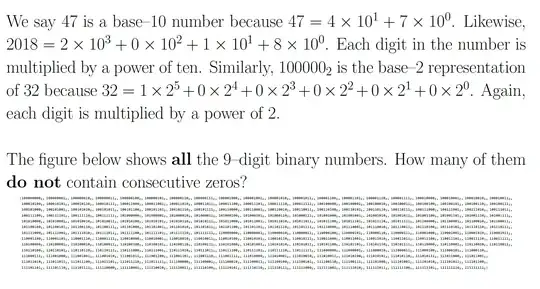Facts:
- Denote $a(n)$ the function that counts the number of binary strings without 2 consecutive 0's.
$$a(1)=2$$
$$a(2)=3$$
- Fibonacci sequence is defined as such:
$$f(0)=0,\;f(1)=1,\;f(2)=1$$
$$f(n)=f(n-1)+f(n-2)$$
$$f(3)=2,\;f(4)=3$$
- Obviously, $a(n)=f(n+2)$, why? Since $a(1)=f(1+2)=2$
- Therefore, this come down to finding the closed form of $f(n+2)$ for Fibonacci sequence.
Solution technique:
- Establish the characteristics equation and its roots.
$$r^2-r-1=0$$
$$r=\frac{1\pm\sqrt5}{2}$$
- Assume $f_n=c_1r_1^n+c_2r_2^n$, where $r_1$ and $r_2$ are distinct roots in this case.
- Find $c_1,\;c_2$
$$r_1=\frac{1+\sqrt5}{2},\;r_2=\frac{1-\sqrt5}{2}$$
$$f_0=c_1r_1^0+c_2r_2^0=c_1+c_2=0$$
$$f_1=c_1r_1^1+c_2r_2^1=c_1r_1+c_2r_2=1$$
$$\left[\begin{array}{cc|c}1&1&0\\\frac{1+\sqrt5}{2}&\frac{1-\sqrt5}{2}&1\end{array}\right]=\cdots=\left[\begin{array}{cc|c}1&0&\frac{1}{\sqrt5}\\0&1&-\frac{1}{\sqrt5}\end{array}\right] $$
Therefore, the closed form of $a(n)$ is:
$$a(n)=f(n+2)=\frac{1}{\sqrt5}(\frac{1+\sqrt5}{2})^{n+2}-\frac{1}{\sqrt5}(\frac{1-\sqrt5}{2})^{n+2}$$
How many possible 9-bits strings?
$2^9$
How many of 9-bits strings do not contain consecutive zeros?
$$a(9)=f(11)=\frac{1}{\sqrt5}(\frac{1+\sqrt5}{2})^{11}-\frac{1}{\sqrt5}(\frac{1-\sqrt5}{2})^{11}$$
